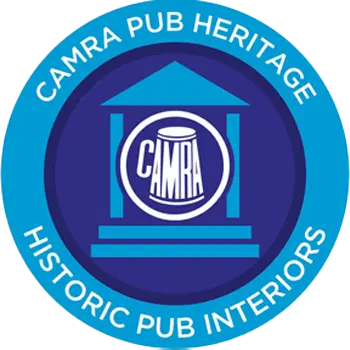

Situated in the town centre near local bus routes and a short walk from the railway station. The pub re-opened under new management after a short closure in autumn 2019. It retains all the features that classify it as having a nationally important historic interior, in particular the exceptional large tiled paintings of scenes of local interest. Draft cider on sale is Weston's Old Rosie, not real cider according to CAMRA's definition.
Historic Interest
Historic Interior
Two star - A pub interior of very special national historic interest
Listed status: II
This pub is included here for one reason – the most resplendent pictorial pub tiling in England, rivalled in the UK only at the Café Royal, Edinburgh. An existing pub was renamed after Henry Havelock, a hero in the Indian Mutiny of 1857, who sits proudly astride his horse by the Havelock Street entrance. This is, like the rest of the tiling, from a refit in 1889–90 and an inscription tells us it came from A.T.S. Carter of Brockley, south-east London. The son of Jesse Carter of tile-makers Carters of Poole, Arthur set up as a builders’ merchant from the mid-1870s. He soon became a tile merchant, but although his firm produced mosaic, it seems he bought in tiles from larger firms – Doulton in this case. Lining a former corridor are scenes depicting Hastings Castle, a mightily energetic Battle of Hastings, and a sea engagement in which stout-hearted English fishermen, lay into a French pirate ship, the appropriately named Cormoran Affamé (hungry cormorant). Since the English vessel is labelled ‘Conqueror, Hastings’, the correct outcome can be in no doubt! Below is a relief tile dado while the floor has black-and-white geometrical designs and bears the name of the pub.
This pub is included as a Heritage Pub only for its exceptional tiled paintings, described by the Tiles & Architectural Ceramics Society as "This wonderful interior must be amongst the candidates for the best turn-of-the-century pub tile scheme in Britain. It certainly stands comparison with Sunderland’s Mountain Daisy, where the 1900-2 tiling (with seven picture panels and a ceramic bar counter) is by Craven Dunnill.” Other magnificent displays of tiled paintings can be found at Café Royal, Edinburgh, Scotland; Mountain Daisy, Sunderland, Tyne & Wear; Central Bar, Leith, Edinburgh, Scotland; Rose Villa Tavern, Hockley, Birmingham; St James TavernDolphin, Hackney, London E8;andGolden Cross, Cardiff, Glamorgan, Wales.
Built c.1857 as a small town centre hotel, the date of the death of General Havelock, this is a four-story building in Italianate style. It was refitted in 1889-90 by a local architect Ward with murals by Royal Doulton artists. Although now just one room, it has one of the finest displays of tiled paintings anywhere in the UK. The east side wall is completely covered in tiles and in the upper part are three Royal Doulton panels depicting Hastings Castle, the Battle of Hastings and a sea engagement between three vessels including the Hastings vessel Conqueror and a French pirate ship. Colourful tiled panels with a floral design on the left and right of each painting. The lower part includes small ceramic panels "The Battle of Hastings.A.D.1066"; "Hastings Castle"; and "English Fishermen Boarding a French Pirate".
Also in the right hand porch on Havelock Street side there is a fine Royal Doulton panel depicting General Havelock sitting astride a white horse. Below the painting are more tiles and a small ceramic panel 'General Havelock'. On a tile to the bottom right of all the paintings is the detail "This Tiling was Executed by Alfred T S Carter, Brockley, London SE" (but can't be spotted alongside the Hastings Castle one as it and part of the tiled painting is obscured by some wood panels). Carters (later Poole Pottery) may have commissioned the murals and they are thought to be the work of either John Eyre or John H McClennan.
Originally a passageway ran through the pub from the disused left hand door on Havelock Street to the present entrance on Robertson Street as identified by the black and white tiling on the floor near the tiled paintings and there are mosaic 'The Havelock' on the Havelock Street end and 'Havelock' on the Robertson Street end. A partition would have separated the passage from the rest of the interior which would have been divided by further partitions into probably three separate rooms each accessed by a door in the partition. The two short partitions attached to the tiled wall look modern. On Havelock Road side there is a late C19 pub front with elliptical bowed centre and etched glass flanked by tiled pilasters to left and right.
It is difficult to date the panelled bar counter but the barley twist columns and super structure are definitely modern. There are two different bar back fittings either side of a modern dumb waiter in the centre - the right hand bar back fitting is a quality one with mirrored panels and again difficult to date whereas the left hand section is of a totally different design and definitely post-war; some lower shelves have been lost for fridges. The whole room has a very good boarded ceiling with lozenge-shaped ribs.
This Pub serves 2 changing beers and 0 regular beers.
Havelock, Hastings
Changing beers typically include: Sharp's (varies) , Timothy Taylor - Landlord
Notice an error or missing details? Help us keep our pub & club information accurate by sharing any corrections or updates you spot.